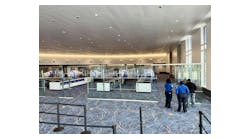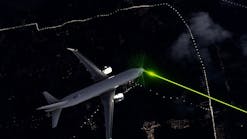New technology is emerging in people’s personal and professional lives, so it only makes sense that airports are using it in areas including running more efficiently and making a better passenger experience. Two airports discuss how they are using technology to take their operations to the next level.
Phoenix Sky Harbor International Airport is currently overseeing the Terminal 3 Modernization Program. Originally opened in 1979, at the time it set new standards in air terminals, with airline ticket counters and baggage claim on the ground level, and shops, restaurants and access to the gates on the second. But now the city of Phoenix is embarking on a $590 million project that will include new passenger amenities, custom-design spaces and an enhanced traveling experience with a focus on convenience and efficiency.
Art Fairbanks is the airport’s project administrator and Steve Rao is the design team director. “One major improvement coming to Terminal 3 is the use of common-use technology kiosks. The benefit is that it offers flexibility for the airport and the airlines,” said Fairbanks. “We will have them installed at ticket counters and at gates.”
Technology at security checkpoints and baggage are big trends in the industry, and Sky Harbor is joining by building a consolidated line. “We don’t control what the Transportation Security Administration does, but we can partner with them,” said Fairbanks.
“We’re building in the ability to allow TSA to incorporate the latest and greatest technology to make things better for passengers,” said Rao. “We will have real-time sensors to scan for line wait times using SITA’s QueueAnalyzer.”
QueueAnalyzer, part of SITA’s Day of Operations Business Intelligence services, was launched about a year ago, said Matthys Serfontein, vice president Airports. Airport using the technology include Orlando International Airport and Phoenix Sky Harbor International Airport.
“Other major US airports are currently running pilots with a view to full implementation. Over the coming months, there are also plans to roll it out in some of the world’s largest airports in Europe and Asia,” said Serfontein.
With QueueAnalyzer, passengers can view security wait times before they travel as well as when they arrive at the airport, said Serfontein. “Real-time checkpoint wait times can be available on the airport’s website, as well as on flight information displays in the terminals and ground transportation,” he explained. “By combining historical and real-time data with powerful algorithms, QueueAnalyzer delivers highly accurate wait-time predictions.”
The direct, and almost immediate, impact has been shorter wait times at Orlando, said Serfontein, which now has 53 percent fewer passengers spending more than 15 minutes in line. “As well as providing passengers with the information they need, SITA QueueAnalyzer provides airport management with dashboards to assess current wait times and view live video of lines,” he said. “It also provides dashboards for quick analysis of real-time information against historical data, allowing for better allocation of resources to avoid bottlenecks.”
SITA QueueAnalyzer provides the airport with a real-time view of the TSA checkpoints, said Serfontein. “This enables rapid response to unexpected conditions, helping ensure the airport authorities and the TSA can work together to minimize disruption,” he said. “It also provides predictions which supports planning to avoid delays when possible.”
The critical thing with checkpoints now are wait times, said Fairbanks. “Whether they’re at home or at the airport, passengers want to know how much time they will need to get through the checkpoint,” he said. “We’ll have times posted on our website and via digital displays in the area to help with those messages.”
Another big trend is wayfinding, which is especially important in new facilities. Sky Harbor’s Terminal 3 was a lot of heavy pre-cast concrete, with dark tinted glass, said Rao. “We’re pulling that away so you can see the ticket counters and baggage carousels, along with seeing where you need to go,” he said. “We opened up both floors and they will now have great views of the city. Things are much easier to find.”
The baggage system is also getting a major upgrade, said Rao. “We’re installing a state-of-the-art Pteris system,” he said. “It will be a flexible system that allows airlines to use more carousels if they have multiple flights coming in.”
Further north, Salt Lake City International Airport is building an entirely new facility under its $2.9 billion terminal redevelopment program. Director of technology Ed Cherry noted that everything being done at airports across the country is more technology oriented.
“Things like the building and construction is important, but everything that touches the passengers and the airlines is technology-based,” said Cherry. “We have to look at what goes into the airport of the future, and that’s different that what we did 20 to 30 years ago,” he said. “We’ve planned ahead, so we have put in enough infrastructure to have any kind of technology and communications systems that we may need, because we can’t guess what may happen in the next 10 years. But we’ll be ready for it.”
While the Salt Lake City project won’t be building the actual security checkpoint, it is helping supplement that function by managing all the doors and portals, said Cherry. “But we will provide all video surveillance in the airport, and that will include using it to monitor security lines.”
The airport is also installing a queue management system so passengers will know how long lines are, said Cherry. “It will also be an aid for TSA to help them plan on when to open more lines and better facilitate getting travelers throughout checkpoints,” he said. “It will also be available to passengers on our website and on display screens in the airport.”
Wayfinding will be an important part of Salt Lake City’s project, said Cherry. “The facility we’re building is much larger than what we currently have, so this has become more important, especially for those who have to walk,” he said. “We have invested significant time and effort looking at pathways for passengers in all parts of the airport, from garages to gates.”
With that, passengers will need static and dynamic signs to aid them, said Cherry. “And we’ve been looking at it from a user’s standpoint, asking ‘what would I like to see in an airport I’m not familiar with,’” he said.
The airport is also building a bifurcated ticketing operation, said Cherry. “We will still have a standard ticketing hall, but we’ll also have an annex attached to the new parking garage that will allow travelers to check in as they come from the rental car or parking facilities,” he said.
Salt Lake City, like Denver International Airport, has travelers who carry oversized items like skis and golf bags, said Cherry. “We’ve installed technology to allow people to check their oversize bags at the annex,” he said. “It can be a big inconvenience to have to schlep these oversized items all the way to the ticket hall.”
Another project that will be in the new terminal is common-use technology at ticketing counters and gates, said Cherry. “It will allow any airline to use a ticket position or a gate. When you’re planning ahead years in advance, you don’t know who will want to fly in and out of here. We recently added Air Canada and last year we got Alaska Airlines,” he said. We’re not a huge airport like Los Angeles, but we are a major hub for Delta.”
Under this project, the airport wants to make it as easy and painless as possible for airlines who want to start service here, said Cherry. “We will facilitate that in the new terminal. It also will help existing airlines that may want to expand on a seasonal or permanent basis or handle unforeseen circumstances,” he said. “We’re right-sizing our facility to meet the needs of the airlines we serve.”
Both airports have visions of what they want to see once their projects are completed. “In Phoenix, our goal is to improve the passenger experience. By doing that, they can move more efficiently through the building and ensure that the building is IATA Fast Travel-ready for our partners,” said Fairbanks. The Fast Travel program provides self-service options in six areas of a passengers' airport journey: self bag tag printing; document check; flight rebooking; self-boarding; and baggage recovery.
The team at Salt Lake City airport has spent a lot of time discussing when it was planning for the new facility, said Cherry. “One thing we did was listen to what people like about the existing airport. For example, all of our rental cars are connected to our parking structure, which is connected to our main terminal,” he said. “It’s very convenient. They don’t have to get on a bus to get to a car rental facility, and we kept that in the new design.”
The airport has focused on what passengers wanted while meeting needs of its airlines as well, said Cherry. “Folks will be pleasantly surprised that nothing has really changed. It’s just more modernized and offers a better experience.”





